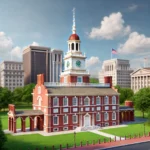The history of America is tightly interwoven with its railroads. From the early steam engines to modern-day rail systems, these tracks have connected communities, fostered economic growth, and transformed the very fabric of the country. The historic railroads of the United States not only carried goods and people across vast distances but also shaped the course of American history. This article takes you on a journey through time, exploring the iconic railroads that have become landmarks in their own right.
The Transcontinental Railroad: Connecting East and West
Arguably the most significant milestone in American railroad history is the completion of the Transcontinental Railroad in 1869. Built by two competing companies—the Union Pacific and Central Pacific—the railroad connected Omaha, Nebraska, to Sacramento, California. This was the first time that the east and west coasts were linked by rail, dramatically reducing travel time and opening new avenues for commerce and migration.
The railroad was not only a technological marvel but also a monumental achievement in terms of human effort. Thousands of workers, including Irish and Chinese immigrants, toiled in challenging conditions to lay the tracks through mountains, deserts, and plains. Today, you can still visit historic sites like Promontory Summit in Utah, where the “Golden Spike” was driven to mark the completion of this groundbreaking project.
The Pullman Company and Luxury Rail Travel
Railroads not only revolutionized the speed and scale of travel but also introduced a new era of luxury. The Pullman Company, founded by George Pullman in the mid-19th century, became synonymous with comfortable, high-end rail travel. The company manufactured luxury sleeper cars and established a standard for refined travel across America.
Pullman’s trains offered plush seating, fine dining, and private compartments, elevating the experience of long-distance travel to new heights. Although the era of luxury rail travel has faded with the rise of airplanes and automobiles, Pullman cars remain a cherished symbol of a bygone age. Many historic railroads still offer vintage Pullman experiences for tourists today, like those on the Grand Canyon Railway.
The Durango & Silverton Narrow Gauge Railroad: A Scenic Legacy
For those seeking a more picturesque journey, the Durango & Silverton Narrow Gauge Railroad in Colorado offers one of the most breathtaking historic train rides in the country. Originally constructed in 1882 to haul silver and gold from the San Juan Mountains, today it operates as a scenic route for tourists, winding through rugged landscapes and steep canyons.
This railroad is a reminder of how railroads were not only economic lifelines but also conduits to America’s most remote and beautiful regions. The train’s steam engine and vintage passenger cars provide a nostalgic trip into the past, while the stunning natural beauty around it leaves a lasting impression on modern travelers.
The Role of Railroads in World War II
During World War II, America’s railroads played a critical role in transporting troops and supplies. The rail network was vital in moving soldiers between training camps, ports, and deployment locations. In fact, many historians argue that without the efficient operation of America’s railroads, the war effort would have faced significant challenges.
Railroads such as the Pennsylvania Railroad and the Southern Pacific were especially important during this period, ensuring the timely delivery of materials crucial for the war effort. Visitors can explore historic war-related railroad sites like the Railroads and World War II exhibit at the National Railroad Museum in Green Bay, Wisconsin, which highlights the importance of rail transport during this turbulent time in history.
Preserving Railroad History Today
Many of America’s historic railroads have been preserved and continue to operate as tourist attractions, offering visitors a chance to experience rail travel as it once was. From the steam engines of the Virginia & Truckee Railroad to the beautifully restored stations of the California State Railroad Museum, there are countless ways to explore the nation’s rich railroad heritage.
Railroad museums, heritage lines, and special events, such as the annual Railfest in Durango, Colorado, help to keep the legacy of America’s railroads alive. These experiences not only educate visitors about the historical significance of the railroads but also provide a tangible connection to the past through interactive exhibits and authentic train rides.
The historic railroads of America are more than just old tracks—they are symbols of progress, innovation, and perseverance. From their role in uniting a divided nation to the luxury and scenic journeys they continue to offer, railroads remain a significant part of the American story. As you travel across the country, whether on a modern train or a historic line, you’re retracing the paths that helped build a nation.


